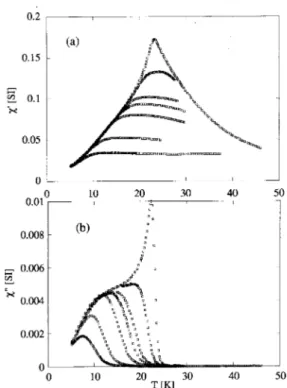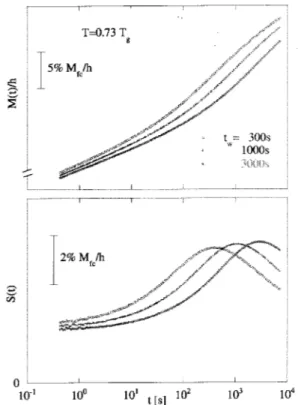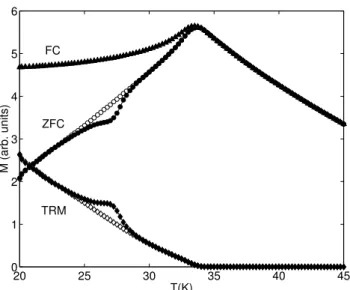The 3d Ising Spin Glass
PerNordblad
Department ofMaterialsSiene,
UppsalaUniversity,
Box534, SE-75121Uppsala,Sweden
Reeivedon5August,2000
Experimentallyderivedphysialpropertiesof3dIsingspinglassesare disussedandomparedto
whatis antiipatedfromtheoryandsimulationsofmodelsystems. It isfoundthatthe spinglass
experienes a zero-eld phase transition to a low-temperature spin-glass phase, that there is no
phasetransition inamagnetieldandthat nonequilibriumandhaoseets oftendominatethe
dynamisofthelow-temperatureglassyphase. These resultsare inagreementwithndingsfrom
MonteCarlosimulationsandwithpropertiesderivedfromthedropletmodel.
I Introdution
3dspinglassesaredesribedbytheEdwards-Anderson
(EA)model:
H = 1
2 X
i;j J
ij S
i S
j
(1)
whereJ
ij
arerandominterationswithzeromeanthat
an be hosen only as nearest neighbor interations
andS
i andS
j
arespinsonaregularthreedimensional
lattie [1℄. This model Hamiltonian is realized bythe
Fe
0:5 Mn
0:5 TiO
3
ompound. The magneti struture
ofthetwoparentompounds ofthis spinglass system
isantiferromagnetiatlowtemperatures;thestruture
maybedesribedbyahexagonallattiewiththespins
direted along the -axis of the rystals. In FeTiO
3
the magneti atoms are ferromagnetially oupled in
thehexagonalplanesbutadjaentlayersare
antiferro-magnetiallyoupled. InMnTiO
3
,ontheotherhand,
neighboring Mn atoms are antiferromagnetially
ou-pled within the layers. Mixing iron and manganese
ausesrandomnessandfrustration,andataboutequal
onentrationof FeandMnatoms,thissystemalmost
ideally reprodues a short range 3d EA spin glass[2℄.
Results from experiments onFe
0:5 Mn
0:5 TiO
3
will be
used to disuss stati and dynami saling analyses
thatsuggesttheexisteneofanitetemperaturephase
transition in zero eld but no phase transition in a
magneti eld. Nonequilibrium dynamis and aging
phenomena [3℄will be exemplied with representative
datafromother3dspinglassmaterials.
II Phase Transition
Isthereaspinglassphaseinreal3dIsingspinglasses?
This keyquestionmaysound trivialto resolve
experi-mentally, but hasturned out to requireextensiveand
areful studies on good model systems to nd a
reli-ableanswer. Weherereallstatianddynamisaling
results on one and the same Fe
0:5 Mn
0:5 TiO
3 single
rystalline spinglass material [4, 5℄. Fig. 1shows the
inandoutofphaseomponentsofthesuseptibilityof
this material in awide frequeny range[5℄, and Fig. 2
shows results from a suseptibility measurements in
superposed d magneti elds [6℄. Someessential
fea-turesofspinglassdynamisanbeseeninthesegures,
twoofwhihare: (i)thereiswideregioninwhih
onse-quenesofaslowingdownofthedynamisareevident
in the a-suseptibility; (ii)there is asubstantial
sup-pressionofthesuseptibilitywitheld.
Theobservedfrequenydependene ofthe
suseptibil-ityallows to safelydistinguisha ritialslowing-down
behavior:
0 =t
z
(2)
where t is the redued temperature ((T T
g )=T
g ),
the relaxation time,
0
the mirosopi spin ip time
and z the dynami ritialexponent. More and less
sophistiated dynami saling analyses of the data of
Fig.1allnallyyieldz=100.5. [5℄
Approahingthe ritialtemperaturethe
susepti-bility,asisimpliedfromFig.2,beomesmoreandmore
eld dependent. This non-linear suseptibility an be
aurately measuredfrom,e.g.,thedependene of the
a suseptibility on aninreasing superposed d eld.
Employing suh data in stati saling analyses yields
Figure1. A-suseptibilityofFe
0:5 Mn
0:5 TiO
3
at dierent
frequeniesfromref.[5 ℄.
Figure 2. Asuseptibility of Fe0:5Mn0:5TiO3 at 125Hz
indierentsuperposedd-eldsvaryingfromtoptobottom
Theonlusionfromthesedynamiandstati
sal-ingresultsisthatthe3dspinglassdevelopstowardsan
equilibriumlowtemperaturephaseasthetemperature
isloweredtowardsT
g .
A more ontroversial problem is whether or not
thereisaspinglassphaseinanappliedmagnetield.
Mean eld solutions of the innite range spin glass
modelsaythatthereisaphasetransitioninamagneti
eld,whereasthedropletmodelfor3dIsingspinglasses
saysno. AnalytialworkandsomereentMonteCarlo
(MC)simulations onshort range 3dIsing spinglasses
[7,8℄supporttheanswerno,whereasotherMCworkis
interpretedtofavoranin-eldphasetransitioninsuh
systems[9℄.
What do experiments suggest? Fig. 3 shows
on-stant relaxation time ontours for our model system
derivedfrom a suseptibility datain applied d
mag-neti elds [6℄. To extrat information on whether a
phase transition is antiipated or not on ooling in a
eld, we have analyzed the slowing down of the
dy-namisalongthetwolines drawninFig.3. Theresult
ofvariousdynami salinganalysesofthedataisthat
theslowingdownisbestdesribedbythefollowingtwo
salingfuntions:
ln(
0 )/T
1
f
(3)
forH =onstantand
ln(
0 )/T
(1+H )
f
(4)
for H=T =onstant, where T
f
is the freezing
temper-ature orresponding to eah relaxation time and, in
termsofthedropletmodel,isanenergybarrier,
H
governsthe eld dependene of theorrelation length
and is thebarrier exponent. Theresultimpliesthat
there is no phase transition in a magneti eld for a
realisti3dIsingspin glass. Theexponent
H
=0.65,
yielding =0.8using aderived valueof the exponent
H
=0.8. Experimentsona3dIsingmodelsystemthus
supportthesenariothatthereisaphasetransitionin
zero eld and no phase transition in a nite eld, in
aordwiththedropletmodelpredition.
III Nonequilibrium dynamis
In this setion the nonequilibrium nature of the spin
glassphaseisdisussed. Mostexperimentsonthiskind
ofdynamis havebeenperformedon3dspinglass
sys-tems of less lear Ising nature than Fe
0:5 Mn
0:5 TiO
3
and we have therefore hosen to exemplify
nonequi-librium dynamis bymeasurements onother, but still
harateristi, spin glass systems. The observed
be-haviorishoweveralsoharateristiof3d Isingmodel
0
5
10
15
20
25
0
1
2
3
T [K]
H [T]
1700 Hz
0.017 Hz
Figure 3. Constant relaxation time ontours for
Fe
0:5 Mn
0:5 TiO
3
in anH-T diagram. The frequenes are
0.017,0.17,1.7,17,170and1700Hzandtheorresponding
relaxationtimest=1=! [6 ℄.
An aging phenomenon in amagneti system is
re-vealed bya nonstationaryresponse to the appliation
of an external magneti eld, i.e., the response
fun-tion depends on the waiting time (t
w
) spent at
on-stanttemperaturebeforethemagnetield isapplied.
Fig.4showsresultsfromzeroeld ooled(ZFC)
mag-netizationmeasurementsona3dspinglassfordierent
waiting times; (Fig. 4a)m(t) vs. log(t) and(Fig. 4b)
the orresponding relaxation rate (S(t) = 1=h m(t)
ln(t) ).
Astrikinghangeoftherelaxationwitht
w
isobserved
and theoureneof amaximum in S(t) at an
obser-vation time of order the waiting time is harateristi
forspinglasses. Inana-suseptibilityexperiment,the
observation time is onstant t = 1=! and at low
fre-queniesaginganbeobservedasaspontaneousdeay
of both the in-phase and the out-of-phase omponent
ofthesuseptibilitywithtimeatonstanttemperature.
Thisbehaviorhasbeenamplydemonstratedinboth2d
and3dspinglassesandalso ours inother frustrated
magnetisystems[11℄.
The omplexity of the nonequilibrium dynamis
of spin glasses is further illustrated in Fig. 5, where
the low frequeny out-of-phase omponent of the
a-suseptibilityisplotted vs. temperature. Thedierent
urveshavebeenreordedonontinuousheatingofthe
sample after dierent ooling proedures: ontinuous
ooling (referene), ooling with one long stop at 40
K(single)and oolingwithlongstopsat twodierent
temperatures, 40 and 50K(double) [12℄. Thedips in
the urves our at the temperatures where the
sam-ple hasbeenkeptat onstanttemperatureduring the
otherwiseontinuousoolingproess. Tworuialspin
glasspropertiesareillustratedbythisgure: (i)haos
- equilibratingthe sample at onespei temperature
yields a spin onguration that appears random at a
dierent temperature; the system isrejuvinated when
thetemperatureishangedand(ii)memory -the
equi-libration that has been imposed on the system at a
tionandisretrievedwhenthattemperatureisreovered
onheating. Theombinedmemoryandhaosbehavior
hasbeenfoundto distinguishaspinglassphasefrom,
e.g., a frustrated ferromagneti phase [13℄ in whih a
rejuvination ours both on heating and ooling, i.e.,
thereisnomemoryeet.
Figure 4. (a) Magnetisation vs. log(t) and (b)the
orre-spondingrelaxation rate(b)measuredafterdierent
wait-ingtimes,t
w
foranamorphousmetalli3dspinglass.
Figure 5. Low frequeny 00
(T), measured on a Cu(Mn)
spin glass on ontinuous heating after ontinuous ooling
(ref), after one halt at 40 K (single) and after halting at
twodierenttemperatures,40and50K,(double).
temperature experiment. Fig. 6shows the ZFC, eld
ooled (FC) and thermoremanent (TRM)
magnetiza-tion measured on aAg(Mn) spin glass by ooling the
sampletoalowtemperatureinonstanteldandthen
applying/keeping/removing (ZFC/FC/TRM) a weak
magnetieldandreordingthemagnetizationon
on-tinuous heating, (open symbols) [14℄. The urves
marked by losed symbols have been reorded in the
same way, the only dierene being that the sample
waskeptataonstanttemperatureT
h
=27Kforsome
hoursduringooling. Thereisamarkeddip(bump)in
the ZFC(TRM) urvein the region aroundT
h . This
behavioragainillustrateshaosandmemoryinthespin
glass phase. (This simpleexperimentanbemade on
anyhighresolutionmagnetometersystemtodistinguish
aspinglassphasefromotherdisorderedphasesin less
wellunderstooddisorderedsystems).
20
25
30
35
40
45
0
1
2
3
4
5
6
T(K)
M (arb. units)
ZFC
FC
TRM
Figure6. ZFC,FCandthermoremanent(TRM)measured
onheatingafteroolingtheAg(Mn)spinglassto20Kand
then measuring on heating. Theurvesmarked with full
symbolsrepresentasamplesubjetedtoalongstopat
on-stanttemperature(27K)andeldduringooling[14 ℄.
IV Disussion and onlusions
In this paper we have reapitulated somekey
experi-mental propertiesof 3dspinglasses. Theobserved
be-haviorsupports many features inherentto thedroplet
model of short-range 3d spin glasses. The questions
regarding thephase transition are answeredin aord
with this model: there exists azero eld phase
tran-sition, but there is no phase transition in a magneti
eld.
Nonequilibrium dynamis, whih in the droplet
model is related to the growth of spin glass ordered
withthedropletpiture. Thememoryphenomenon is
afeaturethatperhapsanbeinorporatedinadroplet
piture[15℄ormayrequirealternativeapproahes[12℄.
There are urrently major eorts to understand the
nonequilibrium and aging phenomena that disordered
andfrustratedphysialsystemspossess[16℄.
Aknowledgments
FinanialsupportfromtheSwedishNaturalSiene
ResearhCounil(NFR) isaknowledged.
Referenes
[1℄ ForreentreviewsonspinglassesseeSpinGlasses and
RandomFields,A.P.Young,Ed.,(WorldSienti,
Sin-gapore,1998).
[2℄ H.ArugaandA.ItoJ.Phys.So.Jpn.62,4488(1993).
[3℄ L. Lundgren,P.Svedlindh, P.Nordblad, andO.
Bek-man,Phys.Rev.Lett.51,911(1983).
[4℄ K.Gunnarsson,P.Svedlindh,P.Nordblad,L.Lundgren,
H.Aruga,andA.Ito,Phys.Rev.B43,8199 (1991).
[5℄ K.Gunnarsson,P.Svedlindh,P.Nordblad,L.Lundgren,
H.Aruga,andA.Ito,Phys.Rev.Lett.61,754(1988).
[6℄ J.Mattsson,T.Jonsson,P.Nordblad,H.ArugaKatori,
andA.Ito,Phys.Rev.Lett.74,4305(1995).
[7℄ Seee.g.,M.Palassini,andA.P.Young,Phys.Rev.Lett.
83,5216 (1999); M.Palassini, andA. P.Young,
ond-mat/0002134,andreferenestherein.
[8℄ Seee.g.,M. A.Moore, H.Bokil, andB.Drossel, Phys.
Rev.Lett. 81, 4252 (1998). B. Drossel, H. Bokil, and
M.A.Moore,ond-mat/0007315,andreferenestherein.
[9℄ Seee.g.,E.Marinari,G.Parisi,andJ.J.Ruiz-Lorenzo,
inSpin Glasses andRandom Fields,A.P.Young,Ed.,
(WorldSienti,Singapore,1998),p.59,andreferenes
therein.
[10℄ P.Jonssonetal.,unpublished.
[11℄ P. Nordblad, in Dynamial Properties of
Unonven-tionalMagneti Systems, A. T.Skjeltorpand D.
Sher-rington.Eds.,(Kluwer,1998),p.343.
[12℄ K.Jonason,E.Vinent,J.Hammann,J.P.Bouhaud,
andP.Nordblad,Phys.Rev.Lett.81,3243 (1998).
[13℄ E.Vinent,V.Dupuis,J.Hammann,M.Alba,andJ.
P.Bouhaud,Europhys.Lett.50,674(2000).
[14℄ R.Mathieu,D. N.H.Nam,P.Jonsson,andP.
Nord-blad,ond-mat/0007070.
[15℄ T.Jonsson,K.Jonason, P.Jonsson,and P.Nordblad,
Phys.Rev.B59,8770 (1999).
[16℄ J.P.Bouhaud,L.F.Cugliandolo,J.Kurhan,andM.
Mezard M., inSpinGlasses and Random Fields,A. P.


